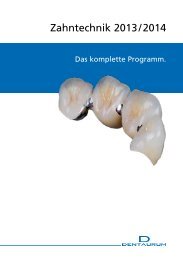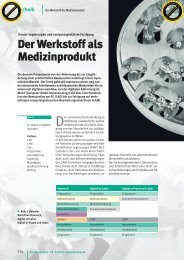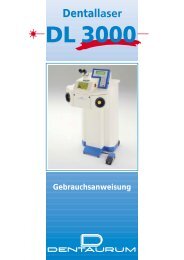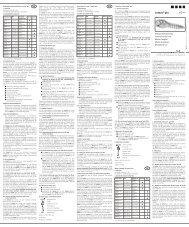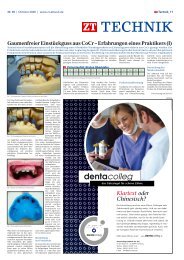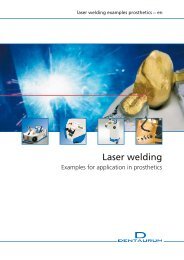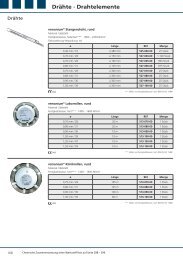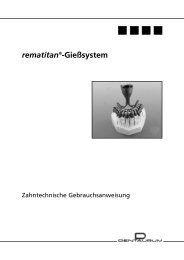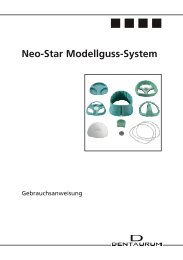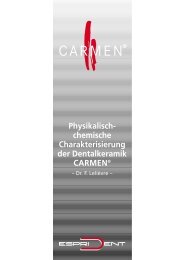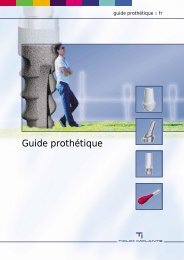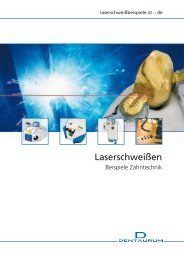Junior 3000 Gebrauchsanweisung - DENTAURUM
Junior 3000 Gebrauchsanweisung - DENTAURUM
Junior 3000 Gebrauchsanweisung - DENTAURUM
Create successful ePaper yourself
Turn your PDF publications into a flip-book with our unique Google optimized e-Paper software.
6.2 Soldering<br />
When soldering, always wear safety goggles. If soldering takes too long, the soldering<br />
!! carbon is damaged.<br />
! When using hand electrodes for soldering or heat-treating, the electrodes must not<br />
touch each other at the electrode holders. However, if they do touch one another, a<br />
fault signal is given. If the carbon electrode is used, the current flows through the<br />
electrode holder and through the hand electrodes, causing poor soldering results.<br />
• For soldering purposes, one of the copper electrodes is replaced by a carbon electrode<br />
(soldering electrode REF 085-300-00). The heat created by the electrical resistance is stored<br />
mainly in the carbon tip, whereas the metal parts themselves absorb only a slight amount of<br />
heat. The soldering process differs from the welding process by using solder and flux.<br />
• During electric soldering, the carbon electrode leads to continuous heating until the solder is<br />
melted. This then flows around the metal parts which are also heated and protected from<br />
oxidation by the flux.<br />
• Before soldering, the carbon electrode should be cleaned with the emery file, REF 083-300-00<br />
to remove any flux residues, which have an insulating effect and would hinder the flow of<br />
current during the next soldering operation. Replace the carbon electrode before the brass<br />
sleeve and the electrode shaft begin to char.<br />
• We recommend using a pencil sharpener to sharpen the soldering carbon REF 081-601-00.<br />
To increase the conductivity of the soldering carbon, dip the tip in water before beginning<br />
the soldering operation.<br />
• The hand electrodes are not suitable for continuous soldering.<br />
• The soldering carbon offers more resistance to the current than the clamping electrode<br />
REF 081-701-00, thus causing heat to build up in the tip of the soldering carbon. Always<br />
ensure that the carbon tip is placed where the heat cannot damage the parts.<br />
Solders<br />
Solder pellets with flux filling round 25 pcs REF 381-001-00<br />
Working temperature: 700 °C / 1292 °F<br />
Fix the solder tablet on the workpiece<br />
using the solder electrodes of the welding<br />
and soldering unit. The notch prevents it<br />
from slipping, e.g. when welding wires.<br />
Universal silver solder in rods, ready fluxed 1.2 g REF 380-604-50<br />
in rolls, without flux 10 g REF 380-704-50<br />
Working temperature: 700 °C / 1292 °F<br />
Universal silver solder paste<br />
Working temperature: 630 °C / 1166 °F<br />
in syringe with flux 7.5 g REF 380-804-50<br />
Dentaflux ® Universal soldering flux. For all types of<br />
orthodontic soldering. If necessary, dilute<br />
slightly with water.<br />
50 g REF 681-100-00<br />
White gold solder<br />
Working temperature: 950 °C / 1742 °F<br />
in rods, ready fluxed 1.8 g REF 380-600-50<br />
EN<br />
junior <strong>3000</strong> en 37



